Visual Reinforcement Learning with Imagined Goals
Video and details of this work is available here
Introduction and Motivation
Humans are able to accomplish many tasks without any explicit or supervised training, simply by exploring their environment. We are able to set our own goals and learn from our experiences, and thus able to accomplish specific tasks without ever having been trained explicitly for them. It would be ideal if an autonomous agent can also set its own goals and learn from its environment.
In the paper “Visual Reinforcement Learning with Imagined Goals”, the authors are able to devise such an unsupervised reinforcement learning system. They introduce a system that sets abstract goals and autonomously learns to achieve those goals. They then show that the system can use these autonomously learned skills to perform a variety of user-specified goals, such as pushing objects, grasping objects, and opening doors, without any additional learning. Lastly, they demonstrate that their method is efficient enough to work in the real world on a Sawyer robot. The robot learns to set and achieve goals with only images as the input to the system.
Related Work
Many previous works on vision-based deep reinforcement learning for robotics studied a variety of behaviours such as grasping [1], pushing [2], navigation [3], and other manipulation tasks [4]. However, their assumptions on the models limit their suitability for training general-purpose robots. Some scholars proposed time-varying models which require episodic setups. There are also scholars that propose an approach that uses goal images, but it requires instrumented training simulations. There is no example that uses model-free RL that learns policies to train on real-world robotic systems without having ground-truth information.
In this paper, the authors utilize a goal-conditioned value function to tackle more general tasks through goal relabeling, which improves sample efficiency. Specifically, they use a model-free Q-learning method that operates on raw state observations and actions.
Unsupervised learning has been used in a number of prior works to acquire better representations of RL. In these methods, the learned representation is used as a substitute for the state for the policy. However, these methods require additional information, such as access to the ground truth reward function based on the true state during training time [5], expert trajectories [6], human demonstrations [7], or pre-trained object-detection features [8]. In contrast, the authors learn to generate goals and use the learned representation to get a reward function for those goals without any of these extra sources of supervision.
Goal-Conditioned Reinforcement Learning
The ultimate goal in reinforcement learning is to learn a policy, that when given a state and goal, can dictate the optimal action. In this paper, goals are not explicitly defined during training. If a goal is not explicitly defined, the agent must be able to generate a set of synthetic goals automatically. Thus, suppose we let an autonomous agent explore an environment with a random policy. After executing each action, state observations are collected and stored. These state observations are structured in the form of images. The agent can randomly select goals from the set of state observations, and can also randomly select initial states from the set of state observations.
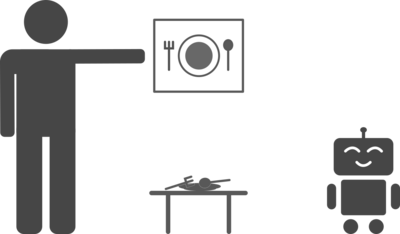
Now given a set of all possible states, a goal, and an initial state, a reinforcement learning framework can be used to find the optimal policy such that the value function is maximized. However, to implement such a framework, a reward function needs to be defined. One choice for the reward is the negative distance between the current state and the goal state, so that maximizing the reward corresponds to minimizing the distance to a goal state.
In reinforcement learning, a goal-conditioned Q function can be used to find a single policy to maximize rewards and therefore reach goal states. A goal-conditioned Q function Q(s,a,g) tells us how good an action a is, given the current state s and goal g. For example, a Q function tells us, “How good is it to move my hand up (action a), if I’m holding a plate (state s) and want to put the plate on the table (goal g)?” Once this Q function is trained, a goal-conditioned policy can be obtained by performing the following optimization

which effectively says, “choose the best action according to this Q function.” By using this procedure, one can obtain a policy that maximizes the sum of rewards, i.e. reaches various goals.
The reason why Q learning is popular is that in can be train in an off-policy manner. Therefore, the only things Q function needs are samples of state, action, next state, goal, and reward: (s,a,s′,g,r). This data can be collected by any policy and can be reused across multiples tasks. So a preliminary goal-conditioned Q-learning algorithm looks like this:

The main drawback in this training procedure is collecting data. In theory, one could learn to solve various tasks without even interacting with the world if more data are available. Unfortunately, it is difficult to learn an accurate model of the world, so sampling are usually used to get state-action-next-state data, (s,a,s′). However, if the reward function r(s,g) can be accessed, one can retroactively relabeled goals and recompute rewards. In this way, more data can be artificially generated given a single (s,a,s′) tuple. So, the training procedure can be modified like so:

This goal resampling makes it possible to simultaneously learn how to reach multiple goals at once without needing more data from the environment. Thus, this simple modification can result in substantially faster learning. However, the method described above makes two major assumptions: (1) you have access to a reward function and (2) you have access to a goal sampling distribution p(g). When moving to vision-based tasks where goals are images, both of these assumptions introduce practical concerns.
For one, a fundamental problem with this reward function is that it assumes that the distance between raw images will yield semantically useful information. Images are noisy. A large amount of information in an image that may not be related to the object we analyze. Thus, the distance between two images may not correlate with their semantic distance.
Second, because the goals are images, a goal image distribution p(g) is needed so that one can sample goal images. Manually designing a distribution over goal images is a non-trivial task and image generation is still an active field of research. It would be ideal if the agent can autonomously imagine its own goals and learn how to reach them.
Variational Autoencoder (VAE)
An autoencoder is a type of machine learning model that can learn to extract a robust, space-efficient feature vector from an image. This generative model converts high-dimensional observations x, like images, into low-dimensional latent variables z, and vice versa. The model is trained so that the latent variables capture the underlying factors of variation in an image. A current image x and goal image xg can be converted into latent variables z and zg, respectively. These latent variables can then be used to represent ate the state and goal for the reinforcement learning algorithm. Learning Q functions and policies on top of this low-dimensional latent space rather than directly on images results in faster learning.
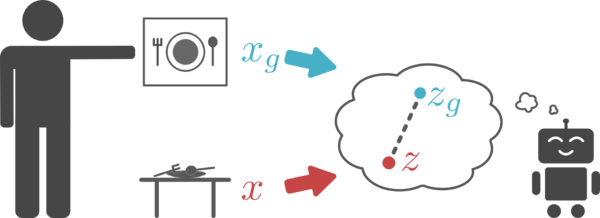
Using the latent variable representations for the images and goals also solves the problem of computing rewards. Instead of using pixel-wise error as our reward, the distance in the latent space is used as the reward to train the agent to reach a goal. The paper shows that this corresponds to rewarding reaching states that maximize the probability of the latent goal zg.
This generative model is also important because it allows an agent to easily generate goals in the latent space. In particular, the authors design the generative model so that latent variables are sampled from the VAE prior. This sampling mechanism is used for two reasons: First, it provides a mechanism for an agent to set its own goals. The agent simply samples a value for the latent variable from the generative model, and tries to reach that latent goal. Second, this resampling mechanism is also used to relabel goals as mentioned above. Since the VAE prior is trained by real images, meaningful latent goals can be sampled from the latent variable prior. This will help the agent set its own goals and practice towards them if no goal is provided at test time.
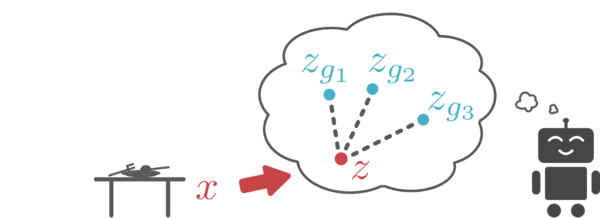
The authors summarize the purpose of the latent variable representation of images as follows: (1) captures the underlying factors of a scene, (2) provides meaningful distances to optimize, and (3) provides an efficient goal sampling mechanism which can be used by the agent to generate its own goals. The overall method is called reinforcement learning with imagined goals (RIG) by the authors. The process involves starts with collecting data through a simple exploration policy. Possible alternative explorations could be employed here including off-the-shelf exploration bonuses or unsupervised reinforcement learning methods. Then, a VAE latent variable model is trained on state observations and fine-tuned during training. The latent variable model is used for multiple purposes: sampling a latent goal [math]\displaystyle{ zg }[/math] from the model and conditioning the policy on this goal. All states and goals are embedded using the model’s encoder and then used to train the goal-conditioned value function. The authors then resample goals from the prior and compute rewards in the latent space.
Algorithm
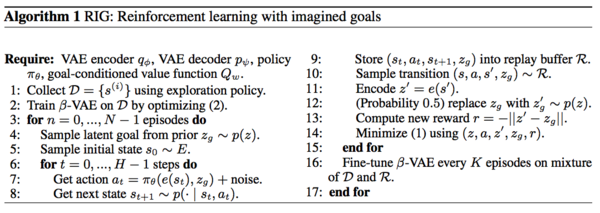
The data is first collected via a simple exploration policy and then train a VAE latent variable model on state observations and then fine tune over the course of training. When the goal-conditioned value function is trained, the authors resample prior goals and compute rewards in the latent space.
Experiments
The authors evaluated their method against some prior algorithms and ablated versions of their approach on a suite of simulated and real-world tasks: Visual Reacher, Visual Pusher, and Visual Multi-Object Pusher. They compared their model with the following prior works: L&R, DSAE, HER, and Oracle. It is concluded that their approach substantially outperforms the previous methods and is close to the state-based "oracle" method in terms of efficiency and performance.
They then investigated the effectiveness of distances in the VAE latent space for the Visual Pusher task. They observed that latent distance significantly outperforms the log probability and pixel mean-squared error. The resampling strategies are also varied while fixing other components of the algorithm to study the effect of relabeling strategy. In this experiment, the RIG, which is an equal mixture of the VAE and Future sampling strategies, performs best. Subsequently, learning with variable numbers of objects was studied by evaluating on a task where the environment, based on the Visual Multi-Object Pusher, randomly contains zero, one, or two objects during testing. The results show that their model can tackle this task successfully.
Finally, the authors tested the RIG in a real-world robot for its ability to reach user-specified positions and push objects to desired locations, as indicated by a goal image. The robot is trained with access only to 84x84 RGB images and without access to joint angles or object positions. The robot first learns by settings its own goals in the latent space and autonomously practices reaching different positions without human involvement. After a reasonable amount of time of training, the robot is given a goal image. Because the robot has practiced reaching so many goals, it is able to reach this goal without additional training:
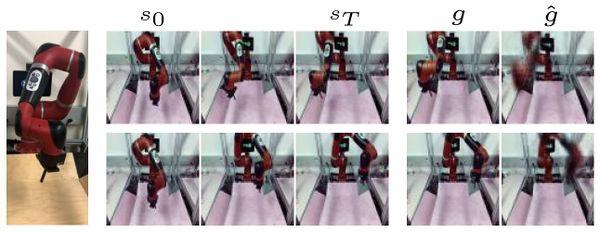
The method for reaching only needs 10,000 samples and an hour of real-world interactions.
They also used RIG to train a policy to push objects to target locations:
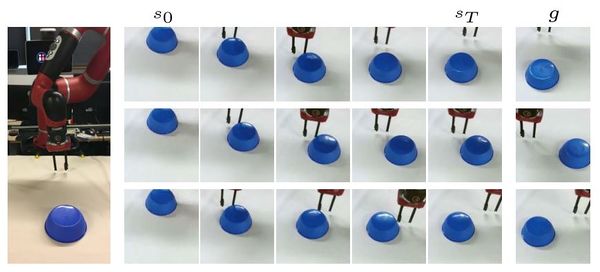
The pushing task is more complicated and the method requires about 25,000 samples. Since the authors do not have the true position during training, so they used test episode returns as the VAE latent distance reward.
Conclusion & Future Work
In this paper, a new RL algorithm is proposed to efficiently solve goal-conditioned, vision-based tasks without any ground truth state information or reward functions. The author suggests that one could instead use other representations, such as language and demonstrations, to specify goals. Also, while the paper provides a mechanism to sample goals for autonomous exploration, one can combine the proposed method with existing work by choosing these goals in a more principled way, i.e. a procedure that is not only goal-oriented, but also information seeking or uncertainty aware, to perform even better exploration. Furthermore, combining the idea of this paper with methods from multitask learning and meta-learning is a promising path to create general-purpose agents that can continuously and efficiently acquire skill. Lastly, there are a variety of robot tasks whose state representation would be difficult to capture with sensors, such as manipulating deformable objects or handling scenes with variable number of objects. It is interesting to see whether the RIG can be scaled up to solve these tasks. [10] A new paper was published last week that built on the framework of goal conditioned Reinforcement Learning to extract state representations based on the actions required to reach them, which is abbreviated ARC for actionable representation for control.
Critique
1. This paper is novel because it uses visual data and trains in an unsupervised fashion. The algorithm has no access to a ground truth state or to a pre-defined reward function. It can perform well in a real-world environment with no explicit programming.
2. From the videos, one major concern is that the output of robotic arm's position is not stable during training and test time. It is likely that the encoder reduces the image features too much so that the images in the latent space are too blury to be used goal images. It would be better if this can be investigated in future. It would be better, if a method is investigated with multiple data sources, and the agent is trained to choose that source which has more complete information.
3. The algorithm seems to perform better when there is only one object in the images. For example, in Visual Multi-Object Pusher experiment, the relative positions of two pucks do not correspond well with the relative positions of two pucks in goal images. The same situation is also observed in Variable-object experiment. We may guess that the more information contain in a image, the less likely the robot will perform well. This limits the applicability of the current algorithm to solving real-world problems.
4. The instability mentioned in #2 is even more apparent in the multi-object scenario, and appears to result from the model attempting to optimize on the position of both objects at the same time. Reducing the problem to a sequence of single-object targets may reduce the amount of time the robots spends moving between the multiple objects in the scene (which it currently does quite frequently).
References
1. Lerrel Pinto, Marcin Andrychowicz, Peter Welinder, Wojciech Zaremba, and Pieter Abbeel. Asymmetric Actor Critic for Image-Based Robot Learning. arXiv preprint arXiv:1710.06542, 2017.
2. Pulkit Agrawal, Ashvin Nair, Pieter Abbeel, Jitendra Malik, and Sergey Levine. Learning to Poke by Poking: Experiential Learning of Intuitive Physics. In Advances in Neural Information Processing Systems (NIPS), 2016.
3. Deepak Pathak, Parsa Mahmoudieh, Guanghao Luo, Pulkit Agrawal, Dian Chen, Yide Shentu, Evan Shelhamer, Jitendra Malik, Alexei A Efros, and Trevor Darrell. Zero-Shot Visual Imitation. In International Conference on Learning Representations (ICLR), 2018.
4. Timothy P Lillicrap, Jonathan J Hunt, Alexander Pritzel, Nicolas Heess, Tom Erez, Yuval Tassa, David Silver, and Daan Wierstra. Continuous control with deep reinforcement learning. In International Conference on Learning Representations (ICLR), 2016.
5. Irina Higgins, Arka Pal, Andrei A Rusu, Loic Matthey, Christopher P Burgess, Alexander Pritzel, Matthew Botvinick, Charles Blundell, and Alexander Lerchner. Darla: Improving zero-shot transfer in reinforcement learning. International Conference on Machine Learning (ICML), 2017.
6. Aravind Srinivas, Allan Jabri, Pieter Abbeel, Sergey Levine, and Chelsea Finn. Universal Planning Networks. In International Conference on Machine Learning (ICML), 2018.
7. Pierre Sermanet, Corey Lynch, Yevgen Chebotar, Jasmine Hsu, Eric Jang, Stefan Schaal, and Sergey Levine. Time-contrastive networks: Self-supervised learning from video. arXiv preprint arXiv:1704.06888, 2017.
8. Alex Lee, Sergey Levine, and Pieter Abbeel. Learning Visual Servoing with Deep Features and Fitted Q-Iteration. In International Conference on Learning Representations (ICLR), 2017.
9. Online source: https://bair.berkeley.edu/blog/2018/09/06/rig/